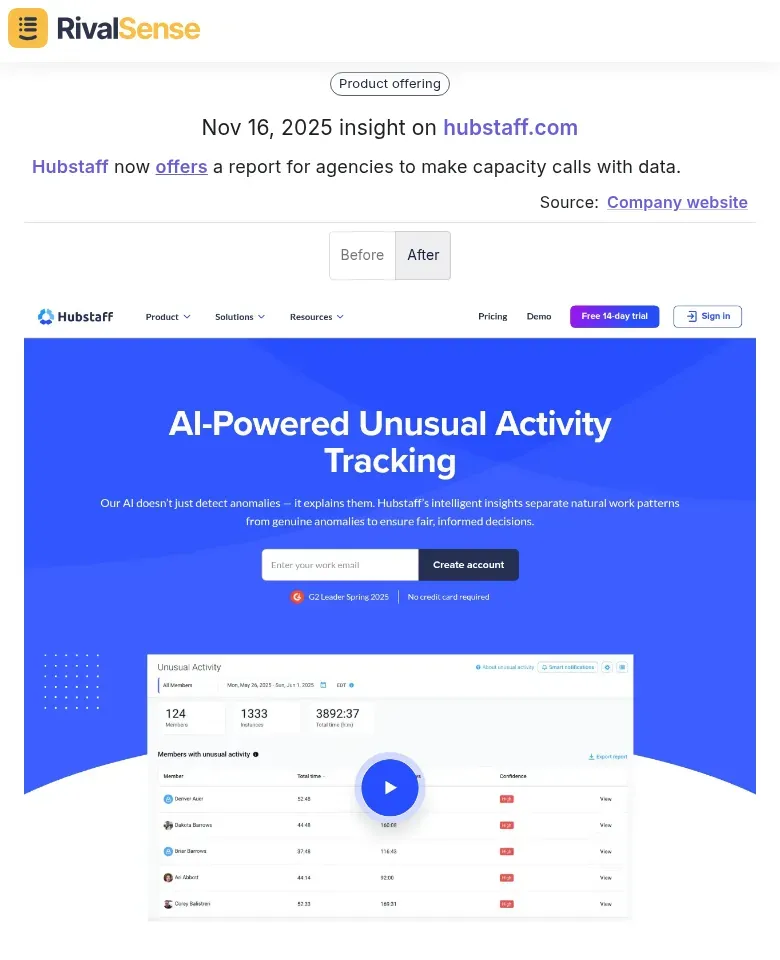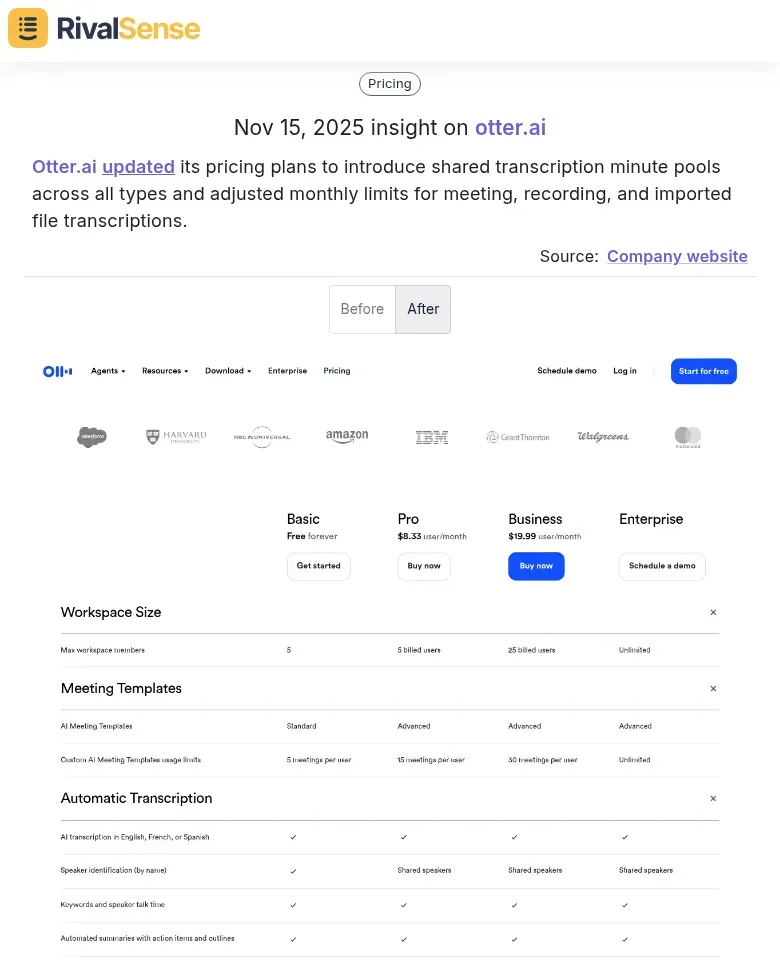Turn Competitor Website Changes into Key Account Wins
In today's hyper-competitive B2B landscape, real-time competitor website monitoring transforms raw competitive intelligence into actionable insights that drive key account wins. Every website change—from pricing updates and feature launches to case study additions—reveals strategic shifts that create acquisition opportunities. For instance, when a competitor removes a key feature, you can immediately target their dissatisfied customers with your superior solution.
Systematic tracking is essential: start by identifying 3-5 primary competitors and monitoring their homepage, pricing pages, blog, and resource sections daily. Use automated tools to track changes and set up alerts for specific keywords like 'enterprise' or 'pricing.' Create a simple checklist: document changes, analyze intent (e.g., market expansion, feature gaps), and identify affected accounts. This disciplined approach helps you spot patterns—like seasonal discount cycles—enabling proactive outreach before competitors can react.
Decoding Geographic Expansion Signals for Market Positioning
When competitors add new locations, they're revealing their market penetration strategy. Track these geographic expansions to anticipate their focus areas and client targeting. For example, if a rival opens offices in Southeast Asia, they're likely targeting manufacturing clients in that region. Insights like Hubble expanding its coworking spaces in Berlin from 2 to 6 locations can be incredibly valuable.  This type of geographic insight helps you understand competitor growth trajectories and adjust your own market positioning to capitalize on emerging opportunities before they solidify.
This type of geographic insight helps you understand competitor growth trajectories and adjust your own market positioning to capitalize on emerging opportunities before they solidify.
Practical steps:
- Monitor competitor websites monthly for location additions 🗺️
- Map new locations against industry clusters and client demographics
- Analyze expansion timing - rapid openings signal aggressive growth
- Compare your current geographic coverage gaps
Use these insights to strengthen your value proposition in emerging markets. If competitors are expanding to tech hubs, emphasize your local partnerships and market-specific expertise. Create targeted messaging that addresses regional pain points they may overlook.
Checklist:
✓ Track location changes quarterly
✓ Identify industry clusters near new locations
✓ Update competitive intelligence reports
✓ Adjust sales territory planning
✓ Develop region-specific case studies
This geographic intelligence helps you position ahead of competitors in growth markets, turning their expansion signals into your account wins.
Leveraging Product Feature Updates for Competitive Differentiation
When competitors launch new features, analyze them strategically to uncover gaps in their offerings. For example, if a rival adds basic analytics but lacks real-time data, this reveals a limitation you can exploit. Tracking feature updates, such as Hubstaff now offering a report for agencies to make capacity calls with data, provides critical intelligence.  This insight is valuable because it highlights competitor focus areas and product weaknesses, allowing you to emphasize your strengths and differentiate your solution effectively in sales discussions.
This insight is valuable because it highlights competitor focus areas and product weaknesses, allowing you to emphasize your strengths and differentiate your solution effectively in sales discussions.
Create a checklist:
- Monitor competitor release notes and changelogs weekly 📈
- Compare features against your product's strengths
- Identify missing elements like integrations or scalability
Translate these gaps into sales advantage points—if a competitor's update omits AI-driven insights, emphasize your superior AI capabilities in demos. Adapt your messaging by crafting talking points that highlight these weaknesses, such as 'While others offer static reports, we provide dynamic, real-time analytics.' This positions your product as the advanced solution, turning their changes into key account wins by addressing unmet customer needs.
Capitalizing on Pricing Strategy Changes for Client Retention
When competitors adjust their pricing structures, they're revealing their value positioning strategy. Monitor these changes closely—track tier adjustments, feature additions to premium plans, or new discount structures. These signals help you understand whether competitors are targeting cost-conscious clients or emphasizing premium value. For instance, Otter.ai updated its pricing plans to introduce shared transcription minute pools and adjusted monthly limits.  Insights into pricing changes are crucial for defending key accounts, as they enable you to anticipate competitor moves and prepare value-based responses that reinforce your solution's ROI and long-term benefits.
Insights into pricing changes are crucial for defending key accounts, as they enable you to anticipate competitor moves and prepare value-based responses that reinforce your solution's ROI and long-term benefits.
Practical steps:
- Set up alerts for competitor pricing page changes 🔔
- Analyze which client segments competitors are targeting with new pricing
- Create a "pricing defense playbook" with pre-approved discount thresholds
- Train sales teams on value-based responses to cost objections
- Regularly review your own pricing flexibility against market movements
Remember: The goal isn't to match competitor pricing, but to demonstrate why your solution delivers greater long-term value, making price a secondary consideration for your key accounts.
Integrating Competitor Insights into Key Account Strategy Execution
Transform competitor website changes into key account wins by integrating real-time insights into your sales strategy. Start by creating dynamic battle cards that automatically update when competitors launch new features, change pricing, or alter messaging. For example, if a rival removes a key feature, your battle card should highlight this gap immediately.
Train sales teams to pivot conversations using these insights. Role-play scenarios where competitors' website changes reveal weaknesses—like discontinued integrations—and practice positioning your solution as the superior alternative. Equip reps with talking points that emphasize your unique value in these gaps.
Measure win rate improvements by tracking metrics:
- Monitor competitor sites daily for changes
- Update battle cards within 24 hours
- Conduct weekly training on new insights
- Analyze win/loss data tied to competitor gaps
Tips: Leverage tools like RivalSense for automated tracking and set up alerts for critical updates. This systematic approach turns competitor moves into your competitive edge, boosting account wins consistently.
Building a Sustainable Competitive Advantage Through Continuous Monitoring
Building sustainable competitive advantage requires systematic monitoring. Start with automated alerts using tools to track competitor website changes—new features, pricing updates, or content shifts—enabling proactive responses. For example, if a rival launches a product, alert your sales team to counter with tailored value propositions.
Establish quarterly reviews: analyze competitor strategy evolution through their blog posts, case studies, and hiring trends. Create a checklist: track feature releases, pricing models, and customer testimonials. Develop feedback loops by correlating sales wins/losses with competitor intel. If a deal is lost due to a competitor's strength, refine your intelligence to highlight your differentiators.
Tips: Use dashboards to visualize trends, and hold cross-departmental meetings to align insights. This continuous cycle turns reactive tracking into strategic wins.
To streamline your competitor monitoring and turn insights into wins, try RivalSense for free at https://rivalsense.co/. Get your first competitor report today and start leveraging real-time intelligence for your key account strategies.
📚 Read more
👉 Master Mystery Shopping: A Step-by-Step Guide to Outmaneuvering Trust Management Competitors
👉 Win-Loss Analysis: Boost Productivity with Financial Competitor Insights
👉 Mastering Competitor Analysis: Insights from Global Events
👉 Track Key Account Feedback: A Practical Guide for B2B Leaders
👉 Cold Chain Logistics Competitor Financial Analysis: Essential Templates and Frameworks
